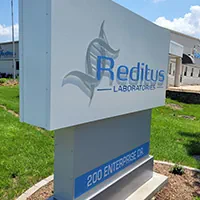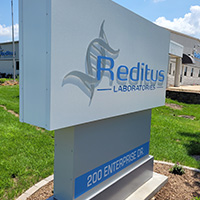Anti-SARS-CoV-2 in Human Serum with Roche e801
Detection of Anti-SARS-CoV-2 in Human Serum with Roche e801
| Test Name: | In vitro test for the qualitative and semi-quantitative determination of antibodies to SARS-CoV-2 in human serum and plasma on Roche/Hitachi cobas e systems. |
| Method Name: | The Elecsys Anti-SARS-CoV-2 S assay uses a recombinant protein representing the receptor-binding domain (RBD) of the spike antigen in a double antigen sandwich assay format. The Elecsys Anti-SARS-CoV-2 S assay detects antibodies to SARS-CoV-2 spike protein RBD. |
| Results: | Technical Range: 0.40-250 U/mL Reportable Range: 0.31-5.61 g/dL |
| Reference Ranges: | ACOV2S Result Interpretation < 0.80 U/mL Negative ≥ 0.80 U/mL – ≤ 250 U/mL Positive, numeric value within measuring interval > 250 U/mL Positive, numeric value reported as > 250 U/mL |
| Clinical Significance: | SARS-CoV-2, the causative agent of Coronavirus Disease 2019 (COVID-19), is an enveloped, single-stranded RNA Betacoronavirus. Seven (7) coronaviruses have been identified as agents of human infection, causing disease ranging from mild common cold to severe respiratory failure.
SARS-CoV-2 is transmitted primarily from person-to-person through respiratory droplets and aerosols. The incubation period from infection to detectable viral load in the host commonly ranges from 2 to 14 days. Detection of viral load can be associated with the onset of clinical signs and symptoms, although a considerable proportion of individuals remains asymptomatic or mildly symptomatic. The interval during which an individual with COVID-19 is infectious has not yet been clearly established, however, transmission from symptomatic, asymptomatic, and pre-symptomatic individuals has been well described. Coronavirus genomes encode 4 main structural proteins: spike (S), envelope (E), membrane (M), and nucleocapsid (N). The S protein is a very large transmembrane protein that assembles into trimers to form the distinctive surface spikes of coronaviruses. Each S monomer consists of an N terminal S1 domain and a membrane-proximal S2 domain. The virus gains entry to the host cell through binding of the S protein to the angiotensin-converting enzyme 2 (ACE2), which is enzymatically active on the surface of numerous cell types including the alveolar type II cells of the lung and epithelial cells of the oral mucosa. Mechanistically, ACE2 is engaged by the receptor-binding domain (RBD) on the S1 subunit. Upon infection with SARS-CoV-2, the host mounts an immune response against the virus, typically including production of specific antibodies against viral antigens. IgM and IgG antibodies to SARS-CoV-2 appear to arise nearly simultaneously in blood. There is significant inter-individual difference in the levels and chronological appearance of antibodies in COVID-19 patients, but median seroconversion has been observed at approximately 2 weeks. Serologic assays can play an important role in understanding viral epidemiology in the general population. |
| Submission Criteria: | For specimen collection and preparation, only use suitable tubes or collection containers. Only the specimens listed below were tested and found acceptable. Serum Plasma: Li-heparin and K2-EDTA plasma Do not use fluoride plasma The sample types listed were tested with a selection of sample collection tubes that were commercially available at the time of testing, therefore not all available tubes of all manufacturers were tested. Sample collection systems from various manufacturers may contain differing materials which could affect the test results in some cases. When processing samples in primary tubes (sample collection systems), follow the instructions of the tube manufacturer. |
| Rejection Criteria: | Rejection criteria include but are not limited to: 1. Specimens containing fibrin or clots. 2. Excessive platelet clumping 3. Leaking specimens 4. Substandard mixing or collection 5. Expired or improperly stored collection tubes. 6. Improperly filled tubes based on collection tube manufacturer’s guidelines. 7. Contaminated specimens (IV fluid, foreign particles, etc.) 8. Specimens not analyzed within the appropriate time frame. 9. Samples not shipped at appropriate temperature. 10. Samples without 2 proper identifiers or samples having identifiers that do not match the electronic or paper lab requisition. |
| Authorization: | Diagnostic testing can only be performed with approval from an authorized provider/agency. |
| Turn Around Time: | 1 da |






